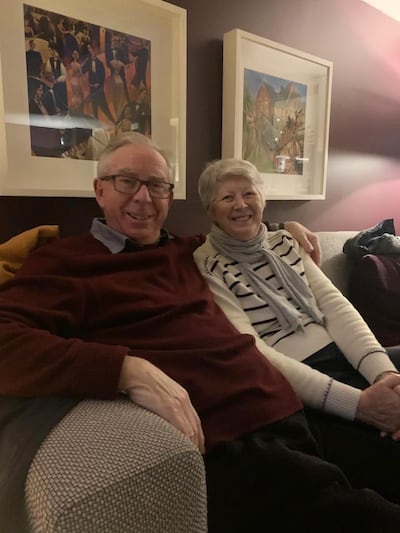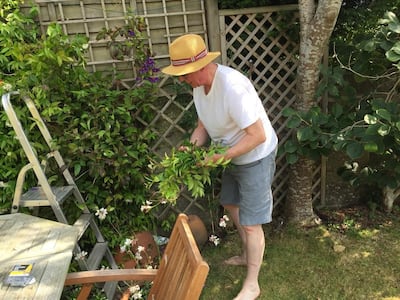Retired secondary schoolteacher John Leeson was weeding in his garden in the south Dublin suburb of Ballinteer on an April afternoon in 2022 when, suddenly, he collapsed.
He managed to pull himself back on to his feet by using his car as a support. Luckily for him, a neighbour noticed him fall and immediately came to his assistance. With the help of another neighbour, they brought him into his house and alerted his wife, Margaret, who was upstairs on the phone, unaware of what had happened.
“There was some discussion about whether I needed an ambulance. I was reluctant to call one because I thought there wasn’t anything wrong with me, but thankfully my neighbour was confident and determined enough to call an ambulance,” he explains.
Leeson had difficulty speaking but was able to communicate with the ambulance personnel when they arrived to take him to St Vincent’s University Hospital. Shortly after his arrival at the emergency department, he was seen by a neurologist who immediately recognised that he had had a stroke.
READ MORE
“Suddenly everything speeded up. I had some tests and scans and was taken by ambulance to Beaumont Hospital for a thrombectomy,” explains Leeson who is in his 70s. A thrombectomy is a life-saving procedure which, under local anaesthetic, mechanically removes the clot which caused the stroke. “I remember the doctor showing me the clot, which was like a squashed raspberry,” recalls Leeson.
I’m so grateful for the tremendous treatment I received and I’m a lucky man not to be sitting in a wheelchair now
— John Leeson, stroke victim
Following the procedure, he was sent back to St Vincent’s University Hospital where he remained on observation for the next six days.

Now, almost one year later, Leeson – who has recovered fully from his stroke – feels very appreciative of the Irish medical system which acted so quickly and effectively. “I’m well aware of the devastation that stroke can cause. I’m so grateful for the tremendous treatment I received and I’m a lucky man not to be sitting in a wheelchair now.”
Stroke is the second leading cause of death in Ireland, after a heart attack, and the leading cause of acquired neurological disability in adults. But if people act fast when the first symptoms appear, many stroke deaths can be prevented and follow-up rehabilitation programmes can help people recover faster.
Common symptoms
The Irish Heart Foundation (IHF) is currently running a campaign reminding the public of the most common symptoms of stroke.
The FAST acronym is used to explain that the most common symptoms of a stroke are identified in the Face, Arms, Speech and that once any of these symptoms are identify, Time is crucial and an ambulance must to called immediately.
“Every minute counts when it comes to getting the person to hospital, because brain tissue doesn’t survive long without blood supply,” explains Prof Ronan Collins, clinical associate professor in stroke medicine at Trinity College Dublin and director of stroke services at Tallaght University Hospital. About 85 per cent of strokes are caused by a blockage of blood in the brain. These are known as ischemic strokes. About 15 per cent are caused by a rupture of blood vessels in the brain, which are called haemorrhagic strokes.
Prof Collins says the easiest way to identify symptoms is to ask the person to smile (to see if the facial muscles are temporarily paralysed), to lift their arms straight in front of them (to see if their muscles are weakened) and to repeat a simple phrase (to see if their speech is distorted or garbled).
Acting fast can be the difference between walking out of hospital after a few days or spending the rest of your life being unable to walk or talk and being dependent on others
— Chris Macey, director of advocacy at the Irish Heart Foundation
A so-called thunderclap headache is another key symptom of a stroke. “It will be the worst headache you have ever had in your life,” explains Prof Collins. Sudden loss of balance (ataxia) is another key symptom.
John Leeson experienced only two of the above symptoms, loss of balance and speech distortion, but they were enough to trigger an emergency response to get him to a hospital immediately. Prof Collins says that phoning an ambulance is crucial, as this triggers a different care pathway than bringing the patient to hospital in a car. “Once in hospital, the assessments and scans are done quickly so that the person can be properly diagnosed to see whether the stroke was caused by a blockage or a haemorrhage.”

The medical team can then decide whether the clot can be dissolved (thrombolysis) or mechanically removed (thrombectomy) for an ischemic stroke. In the case of a haemorrhagic stroke, blood thinning medication is stopped and the patient’s blood pressure is closely monitored. Some haemorrhagic strokes will need neurosurgery to repair an aneurysm or relieve pressure in the skull.
Prof Collins says the Irish Heart Foundation’s FAST public awareness campaign on stroke symptoms is hugely important, as people’s awareness of stroke symptoms has declined in recent years. “In 2021, less than half of patients [with stroke symptoms] arrived in hospital within three hours of the onset of their stroke symptoms,” he says. Like CPR training, Prof Collins would like to see school children educated in stroke symptoms, as they might be the ones to witness a stroke in a parent or grandparent.
Stroke units
Chris Macey, director of advocacy at the Irish Heart Foundation, says: “Acting fast can be the difference between walking out of hospital after a few days or spending the rest of your life being unable to walk or talk and being dependent on others.”
There are now stroke units in all Irish acute hospitals and there is a 24/7 on-call service for thrombectomies in Beaumont Hospital in Dublin and Cork University Hospital for all parts of Ireland.














